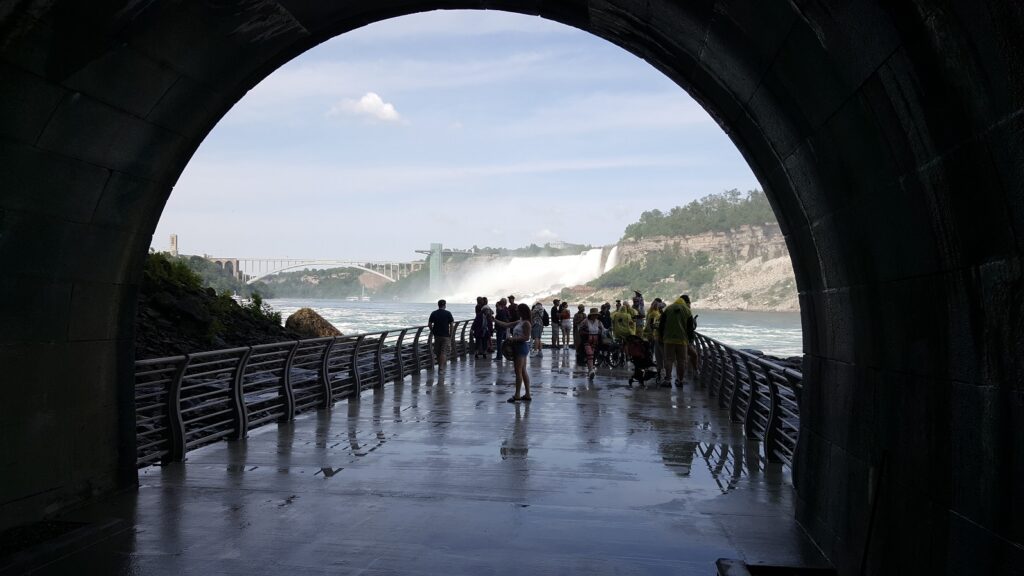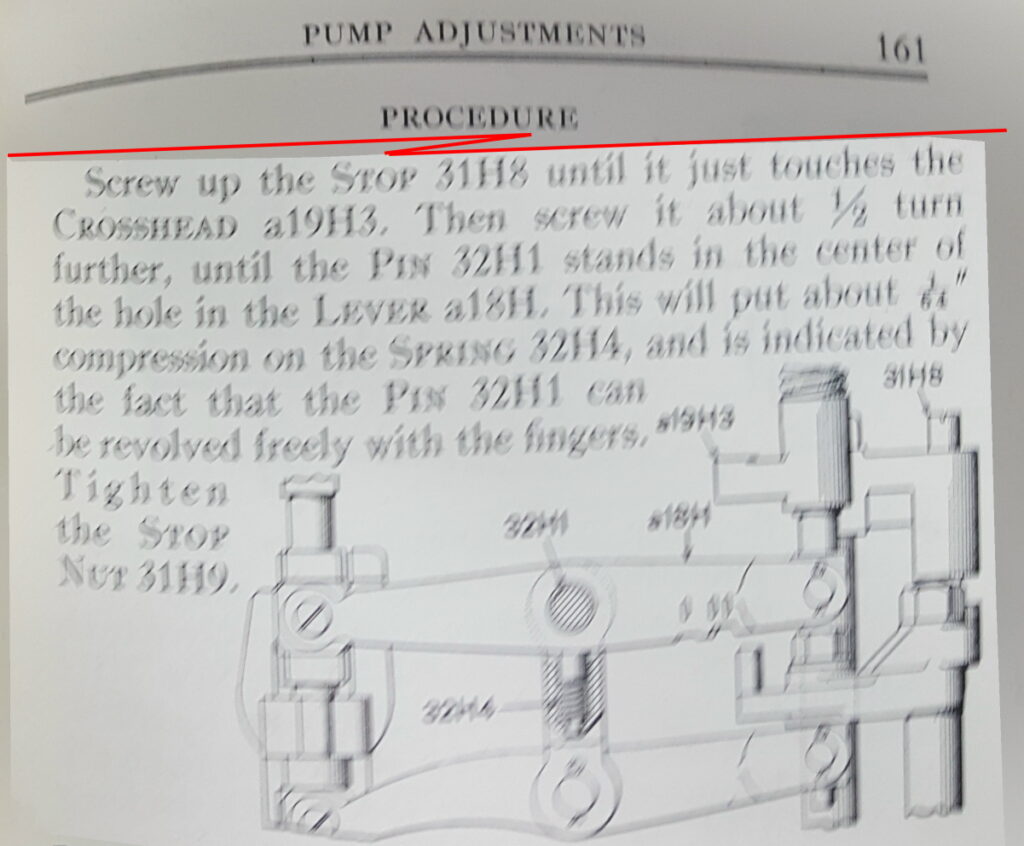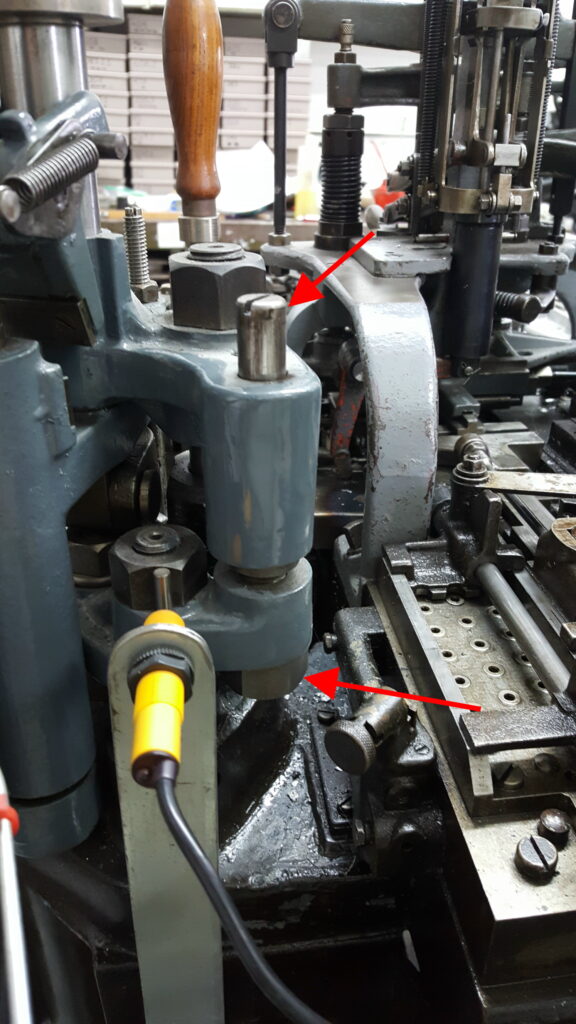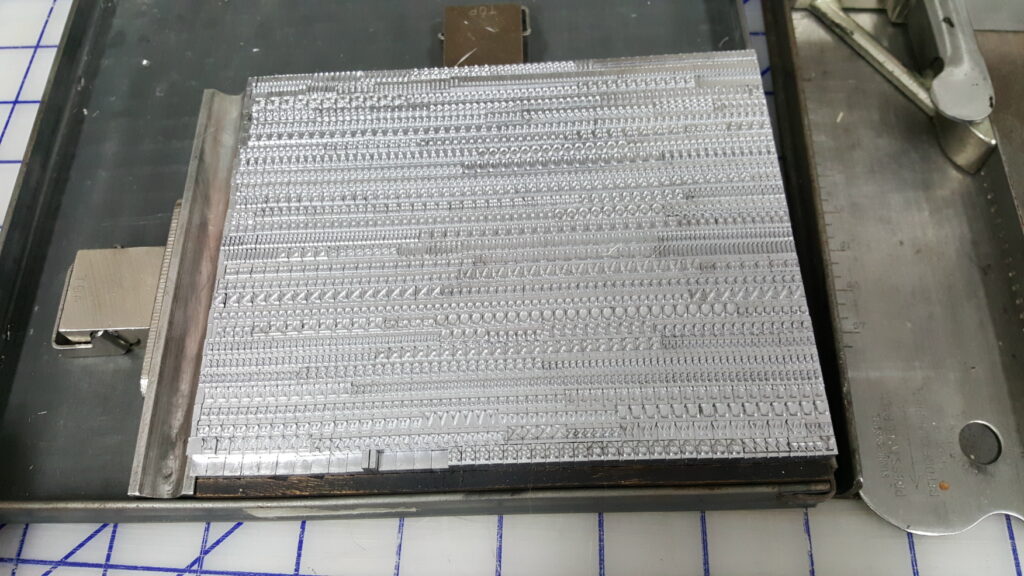As previously mentioned, I’m trying to get the Linotype at the Mackenzie Printery & Newspaper Museum up and running again. I’ve had to fix several problems, and here are the details on one of the problems:
Progress on the Mackenzie Printery’s Linotype (Stuck Keyboard Cams)
As previously mentioned, I’m trying to get the Linotype at the Mackenzie Printery & Newspaper Museum up and running again. I’ve had to fix several problems, and here are the details on one of the problems:
The keyboard cams, which provide the push to release a matrix from the magazine, were seized up pretty much solid. The caster had not been used for a couple years previously, mainly due to COVID restrictions, and the lighter parts of the lubricant had evaporated leaving a gummy residue which effectively glued the cams into their idle position.
Progress on the Mackenzie Printery’s Linotype (Rough Delivery Slide)
As previously mentioned, I’m trying to get the Linotype at the Mackenzie Printery & Newspaper Museum up and running again. I’ve had to fix several problems, and here are the details on one of the problems:
The transfer of the line of matrices from the intermediate channel to the first elevator was very rough, often jamming completely. Manually jiggling the first elevator up and down a bit often, but not always, helped.
Progress on the Mackenzie Printery’s Linotype (1st Elevator Hang)
As previously mentioned, I’m trying to get the Linotype at the Mackenzie Printery & Newspaper Museum up and running again. I’ve had to fix several problems, and here are the details on one of the problems:
During the Linotype’s casting cycle, after the line of matrices did its transfer from the assembly elevator to the first elevator, the latter would fail to descend to casting position, and instead of returning to the right, the delivery slide would become unlinked from its operating lever. The camshaft would stop when the machine failed to detect the first elevator in proper casting position.
Howard Iron Works Print Expo & Fair
After a year or two off due to COVID-19, the Howard Iron Works Print Expo & Fair is on again next month! There will be fewer vendors than previously to maintain physical distancing, but we will have a table there selling paper, marbled paper, and other book arts supplies.
The fair is on Saturday, October 1st, from 10am-4pm, at Howard Iron Works, 800 Westgate Road, Oakville, Ontario (Oakville is just west of Toronto along the Lake Ontario shore).
In addition to shopping at the vendors who will be present at this fair, you can visit the extensive museum of printing equipment, see a lithography demonstration, and participate in a couple of workshops and classes offered that day.
Some Comedy Translation
If you’ve been reading this blog much at all, you may have noticed a link in the sidebar “En Français S.V.P. !”. This invokes Google Translate on the current page, and from there as you follow links, you get translations of the linked pages.
Just today I tried out this feature so see if it still worked. When in the French translation, I happened to go to our Products page that lists typefaces of metal type that I can cast. I got a good laugh when I saw the first few face names translated:
| Audacieux du 20ème siècle | 20th Century Bold |
| Extraordinaire du 20ème siècle | 20th Century ExtraBold |
| Extrabold Condensed du XXe siècle | 20th Century ExtraBold Condensed |
| Lumière du 20ème siècle | 20th Century Light |
| Médium du XXe siècle | 20th Century Medium |
| Condensé moyen du XXe siècle | 20th Century Medium Condensed |
| 20e siècle ultra audacieux | 20th Century Ultra Bold |
| Condensé ultra-audacieux du 20e siècle | 20th Century Ultrabold Condensed |
I found it amusing that “bold” and “extrabold” were essentially translated in their non-typographical meanings, even though “extrabold” is not even a word. I found it interesting that “Extrabold Condensed” didn’t really get translated at all, even though the two words individually were translated elsewhere. I also found it interesting that “20th” sometimes translated into Arabic numerals and sometimes into roman numerals.
The pages aren’t great translations; I suspect that text written using any technical terms, in particular terms that have other meanings in common usage, is difficult to translate properly. In this page it is clear that “type” and “face” are translated with their common English meanings. Improving this would require the translator to identify the subject matter by examining the text overall, perhaps noticing words (like “typeface”) which are unique to that subject.
I still hope they’re useful to a francophone with limited knowledge of English.
The Linotype at Mackenzie Printery and Newspaper Museum
Over the past several weeks I’ve been spending Saturday mornings at the Mackenzie Printery and Newspaper Museum in Queenston, Ontario, near Niagara Falls. This museum is located in the historic house where William Lyon Mackenzie lived for a while and produced the Colonial Advocate which strongly critiqued the government of the time, fomenting unrest which eventually led to the Upper Canada Rebellion and establishment of a more representative government in Upper Canada (what is now Ontario). The building is maintained, and tours and guides are provided, by the Niagara Parks Commission, and a separate group owns and maintains the majority of the printing equipment located there. I’ve been a member of this group for many years, and recently I became a director.
Amidst their collection is a model 5 Linotype linecasting machine.
Niagara Falls Update
We took a day trip to the Falls last Friday, and this time we visited the Niagara Parks Power Station which we missed on our last visit. This station was built in 1905, was in operation for 100 years, and now hosts displays about the development of the station itself and hydroelectricity in general.
When in operation, this station had 11 generators running at 250 RPM to produce 25Hz power. This frequency has been obsolete in North America for decades (we use 60Hz), but local industrial customers were still using it.
You can also take the elevator to the bottom of the pit and walk along the tunnel which use to drain the turbine outfeed to the Niagara River downstream from the falls. The tunnel is well-lit, large (considerably bigger than a train tunnel), cool (refreshing on a hot day) and very humid. At the end of the tunnel there is a viewing platform in the gorge where you can see the Falls and, depending on the wind, get soaked by the mist. Rain ponchos are available free right by the tunnel exit. On the elevator trips you can see the turbine, drive shaft, and penstock for the adjacent generator (I think it was the #2 unit) through the gloom.

The exit of the tunnel, directly facing the American falls. On the platform itself you can also see the Canadian (Horseshoe) Falls and most of the gorge.
We all felt this was a worthwhile stop. It may seem a bit expensive at first, but by Niagara Falls attraction standards it is actually a good deal.
A Good Casting Day
After much thought about my problem with second shot, and with little help from any manuals, I’ve got my caster to behave properly.
The second shot problem was caused by an incorrect adjustment in the pump crosshead and linkage area. The pair of levers that operate the pump have a slotted hole and spring plunger in the link that joins them. When the pump is not in use, this plunger is supposed to be compressed a tiny bit, and it ensures that the pump piston is firmly held at the top of its stroke. The plunger also compresses if the pump piston jams in the down position; very old casters did not have the slot, so a jammed pump would either stall the caster or break something.
The adjustment is described in Casting Machine Adjustments, on page 161 in the copy I consulted: Note that the reference to the pin 32H1 being in the center of the hole in the lever refers to the older casters; in newer casters like mine this hole is a slot in the lever and all that is necessary is the 1/64″ clearance produced by a half turn of the adjusting screw.
Note that the reference to the pin 32H1 being in the center of the hole in the lever refers to the older casters; in newer casters like mine this hole is a slot in the lever and all that is necessary is the 1/64″ clearance produced by a half turn of the adjusting screw.
Here is the adjustment on my caster, as seen from the rear:

Upper arrow is the adjustment screw 31H8, lower arrow is the locknut 31H9. The yellow thing is a sensor for my pump stroke counter.
On my caster, there was no overthrow in the adjustment, and the pivot pin in the linkage had a bit of drag but was not fully loose, and that was enough to allow a bit of a squirt as the pump descended after casting.
The frustrating part of this episode was that the two manuals that described the “second shot” problem never mentioned to check this adjustment. They just contained vague explanations about spring pressures being wrong with no hints as to how to check or adjust them:

From the ‘Monotype’ Composition Caster Manual. A very similar explanation exists in The Monotype Casting Machine Manual.
With this problem tackled, and a new type clamp installed in the type carrier, I got a good font cast: The run was still not problem-free, but the remaining issues did not disturb the lines of type. The remaining problems were:
The run was still not problem-free, but the remaining issues did not disturb the lines of type. The remaining problems were:
- The first type in the line would occasionally fall over in the type channel if it was very narrow (e.g. ‘i’ or ‘l’). This letter would then fall out of the channel altogether, but for font casting missing one lowercase letter is not important, and it also did not leave a significantly shorter line. I thought the type channel had a ridge which engaged the nick of the type, which should prevent this; this is something else to look into.
- On one occasion, the galley cycle was missed; I had to stop the run, remove the extra types that should have been on the next line, and rewind the computer interface to the start of the line. The galley trip is a touchy adjustment; if set too sensitive it will trip during a single justification cycle (which it should not), and the sensitivity depends somewhat on the caster speed.
- During the galley cycle, the rule would sometimes snag on the type in the channel and lift it up as it rose; the type would drop down again each time before the column pusher moved in onto the galley, but there is definitely a chance this might derange the type. This might be due to a slight curve in the rule causing it to press the type against the column pusher a bit.
- I still have a bit of a temperature control problem: Keeping the casting running cool enough for larger type meant that the nozzle could freeze when casting a long run of narrow characters. I got around this by shutting off the mould cooling water while a long run of narrow characters was casting. This is only an issue for font casting; in true composition casting one does not encounter long runs of i’s and l’s! A very distant possibility in the future would be to have the computer interface automatically control the motor speed control of the VFD to vary the motor speed based on a running average of the widths of the type being cast.
Introductory Papermaking Workshop, August 6th 2022
After much delay, we will be holding another Introductory Papermaking Workshop, on Saturday, August 6th, 2022, from 9am to 4pm at our store in New Dundee.
Our workshop last August was held mostly outdoors on our covered porch, but what with lots of things cluttering up our shop and having to dance around COVID restrictions we have not scheduled anything since then.
Well, now we have our shop cleaned up, and indoor gatherings are allowed with no masking requirements, so we’re ready for another workshop. We would still prefer it if attendees had their vaccinations up to date and wear masks, but we are not going to insist on it, and we ourselves will not always be wearings masks, particularly when we are addressing the entire group.
Unfortunately, as with everyone, inflation has hit us, and we have had to increase our workshop fees. This workshop now costs $80.00 plus 13% HST for a total of $90.40; there is no additional materials fee.
We have room for 8 attendees, so if you would like to attend, please contact us to book your spot. We don’t insist on prepayment, but if the course fills up, priority will go to people who have prepaid. You can cancel and get your prepayment back up until a week before the workshop, but after July 30th no refunds will be issued if you cancel. If we cancel the workshop for any reason all prepayments will be refunded.
